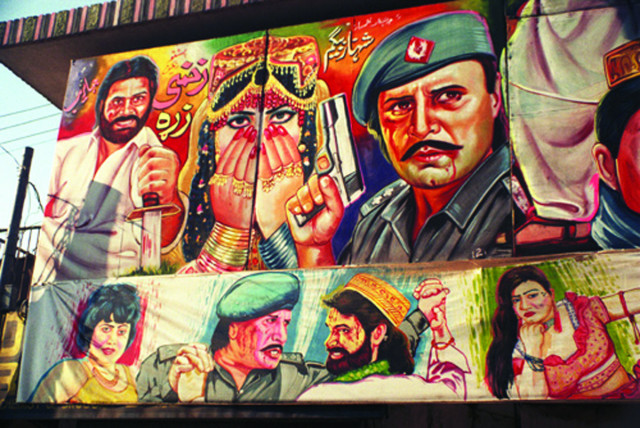Along come Pollywood
A total of five new Pashto films will release this Eid despite fears a low audience turnout due to the floods.

Along come Pollywood
Initially, well-established Pashto poets were keen to utilise this new medium with the basic aim of depicting Pashtun society in its true colours, as a way of highlighting its traditions and romantic aspirations. They largely steered clear of violence, obscenity, vulgarity and the type of firebrand dialogue which was to become the trademark of contemporary Pashto cinema. Cinebuffs still fondly remember the storylines, songs and purposeful screenplays produced during the golden era of Pashtun cinema, that is, the 70s.
The octogenarian Murad Baba is a popular Pashto lyricist and screenwriter, who has to his credit a vast catalogue including 2,000 songs and a hundred Pashto screenplays, including Naway Da Yuway Shpey, Juram Auo Saza and Bungaree Auo Hatkaray.
“Many senior writers like myself had joined the Pashto film industry in the early 70s to promote Pashtun art and culture on the big screen and at the time, it seemed as if we had achieved what we had set out to do,” he says. “Unfortunately, during the late 80s and early 90s some elements with vested interests plagued the industry’s artistic environment and began to present a distorted image of Pashtun society. We raised our voice against it on many forums but nobody listened to us, the result was a sharp decline in the industry and the image of Pashtuns at large.”
He is quick to add that Pashto movies were once so popular that not only would they run in Khyber Pakhtunkhwa, Quetta and Karachi but demand led to reels being smuggled to Kabul with some even making it to Europe and the Gulf.
“It used to take us on average a week to compose and write a song.Nowadays however, standards have been replaced by expediency and an entire film is now conjured up in no time at all and with very little effort. Is this sort of sloppy work going to inspire our younger generation to set goals for itself or exhibit moral integrity?” he asks.
Having hit what can only be described as cinematic rock bottom, the start of the new millennium has seen some efforts to revive films more suitable for a family audience. Pollywood heavyweight Asif Khan’s son Arbaz Khan made his debut with Meena Qurbanee Ghawaree (Love Demands Sacrifice) in 2003. The success of this film spawned some imitations and cineastes cautiously determined that Pashto cinema was showing signs of improvement. In terms of quantity alone, Pollywood frequently releases more films than Urdu and Punjabi cinema, quality notwithstanding.
However actor/director/producer Ajab Gul paints a much more dismal picture, he says, “I suffered huge financial losses from three of my productions last year because of bomb blasts and the growing militancy in Khyber Pakhtunkhwa. There’s also the fact that cinemas themselves are being razed. I am releasing one new film, Jaal, this Eid, which will be shown in Khyber Pakhunkhwa, Karachi, Kabul and Dubai”.
Gul adds that producers take a great financial risk in any case because inflation has rendered costs sky high. “An average Pashto movie costs Rs 7 to 8 million. I want to change the way things work, but my own kitty does not allow me to do it. I need government and public support.” The MMA government, an alliance of nine religious parties in the erstwhile NWFP, imposed a ban on any manner of cultural activity during their tenure. They closed down Peshawar city’s lone cinema, Nishtar Hall, and banned film billboards and posters contributing to the film industry’s downward spiral.
Currently, there are ten cine-theatres in Peshawar, four in Nowshera, two each in Mardan and Bannu and one each in Swat and Kohat. A total of five new Pashto films will release this Eid, leading Ajab Gul to request the Khyber Pakhtunkhwa government to allot him a piece of land in Peshawar on which he might erect a Cineplex using his own resources. The government now appears to be promoting some vestige of culture, going by the remarks of Syed Aqil Shah, the Provincial Minister for Culture, Sports and Tourism, who said, “Cine-going is cheap entertainment and we don’t want the public being deprived of it. Any attempt at damaging cine-theatres comes under the Heritage Act. Some Cine-theatres have been razed recently, but our government marks the end of those days.”
A spokesperson from Shahid Film Productions fears a low audience turnout due to the devastating floods which have wreaked havoc in Khyber Pakhtunkhwa. “The cinema business is already fighting an uphill battle due to militancy, the floods may have come as the final blow. The government should temporarily suspend taxes in order to buffer the cinema owner’s losses,” he suggests.
Muzaffar, a telefilm director from Peshawar reports that over a hundred DVDs of new Pashto movies and at least as many albums will permeate the market in the coming year, despite little official patronage or encouragement. While a cinematic resurrection seems unlikely in the current circumstances, many industry insiders are excited about the potential for expanding the customer-base for Pashto cinema in Afghanistan. As for Pakistan, Ajab Gul hasn’t lost all hope yet, “I believe there is great potential in Pashto cinema, and it can stand on its own feet once the government takes proper initiatives.”
Published in The Express Tribune, August 29th, 2010.


















COMMENTS
Comments are moderated and generally will be posted if they are on-topic and not abusive.
For more information, please see our Comments FAQ